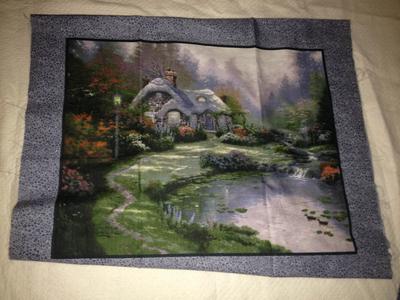This post contains affiliate links for which I receive compensation
Machine quilting picture fabric panels

Jasmine writes...
Hello,I'm wanting to make a Thomas Kinkade quilt. I have found a panel with two pictures. I plan on cutting them out and adding other blocks to it.
Anyway, the only thing I'm stuck on is how to quilt the picture to keep it from bubbling up later. I don't want the threads to show and ruin the picture.
I've seen things on invisible thread. Can this be used? Or is there another method I'm not aware of yet?
Any suggestions would be greatly appreciated.
Thank you,
Jasmine
Julie replies...
Hi Jasmine!If this were my piece and I didn't want my thread to show, I would use invisible or monofilament thread. It can absolutely be used for your quilt.
There are a couple of things to be aware of when using this type of quilting thread.
- Smoke or clear. Monofilament comes in two 'colors' or rather tints. The darker one, Smoke, is used on dark or shaded colors. 'Clear' is used on light fabrics or clear colors. The only way to know which one works best is to test them.
In looking at the panel, I suspect you will use both 'colors' for your quilt. - This type of thread does have a bit of a sheen on it. Try to minimize traveling over the same line more than once so that you don't 'build up' the threads and the amount of 'sheen' in one place.
- My favorite brand is YLI's Wonder Invisible Thread.
It is a 100% nylon thread. Don't iron after quilting as nylon has a lower melting point than polyester.
- Use a smaller needle, like a Schmetz Microtex Sharp 70/10 needle
. The needle eye is appropriate for this fine thread and the shaft creates a much smaller hole in the quilt sandwich. Unlike its cotton counterpart, monofilament won't fill up the holes after it relaxes in the stitch.
When I use monofilament, I use a 50 wt 100% cotton in the bottom. Either Aurifil
You'll also need to adjust your sewing machine tension lower, both because you're using a different thread in the needle and bobbin, and because this type has stretch to it and creates its own tension as it winds its way through your sewing machine.
For more information on using monofilament click here to go to "Quilting with Clear Thread: Tame the Invisible Thread Beast".
One final bit of advice...
...check the quilting distance for the batting that you choose to use in this project. The packaging should list the maximum distance recommended between the quilting stitches.
I hope this has helped with your quilting decision for your Kinkade quilt. I'd love to see it when you're finished! Please consider sharing it on our Share Your Quilts page.
Readers, your comments are most welcome! Please share using the link below.
Thank you!
Piecefully,
Julie Baird
Editor
Comments for Machine quilting picture fabric panels
|
||
|
||
|
||














